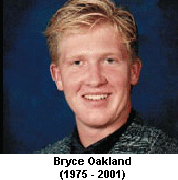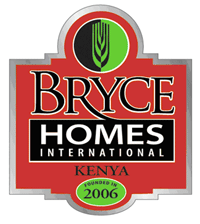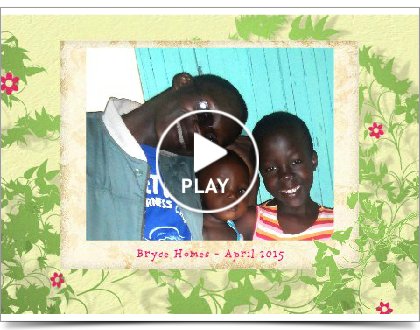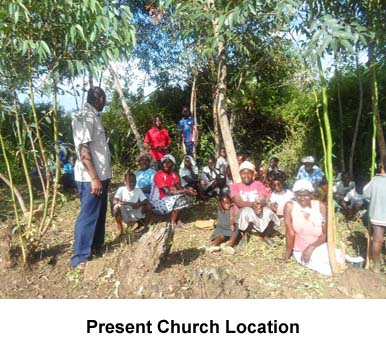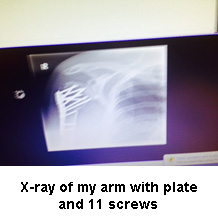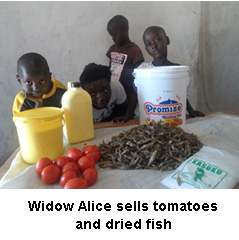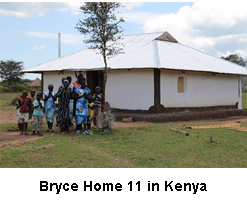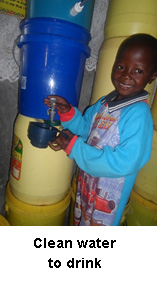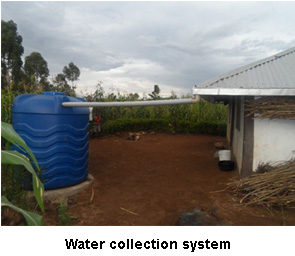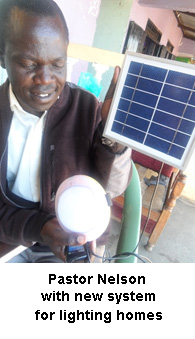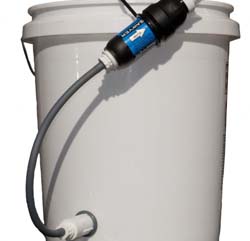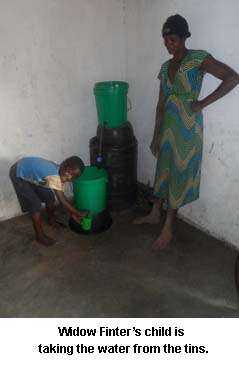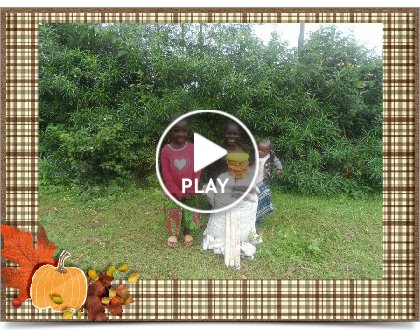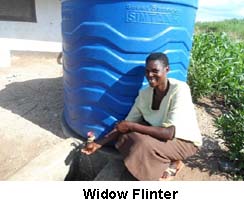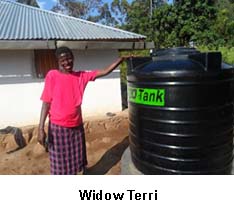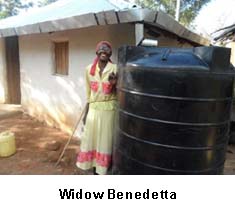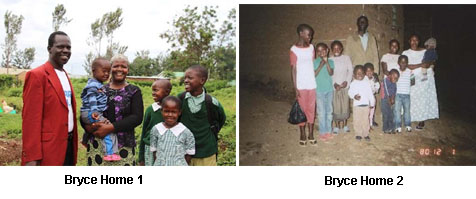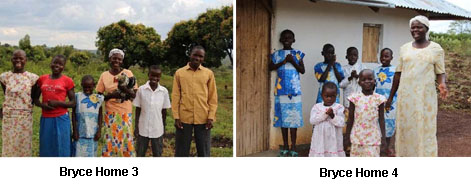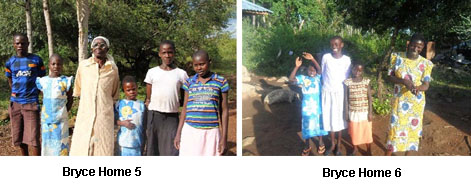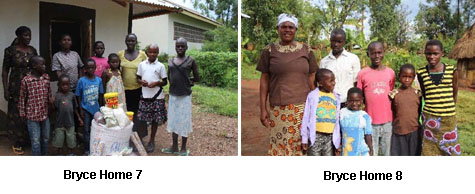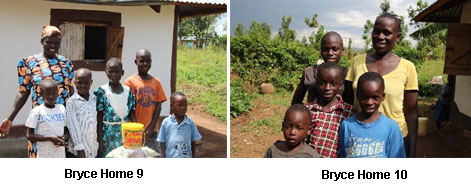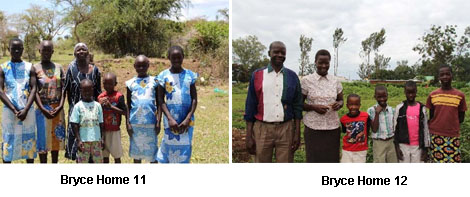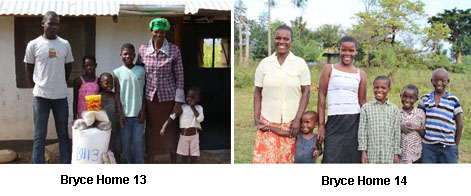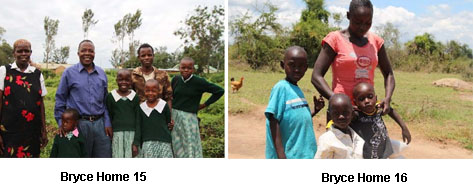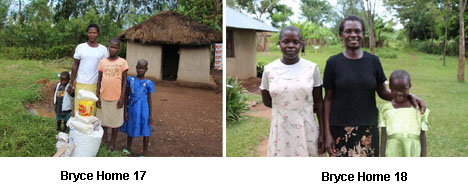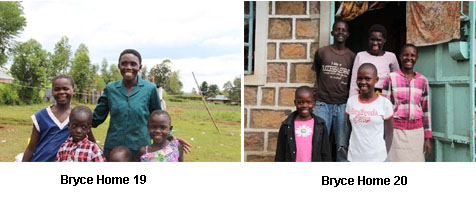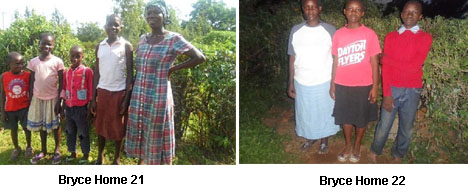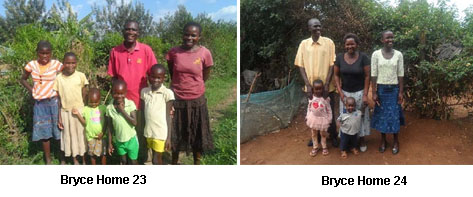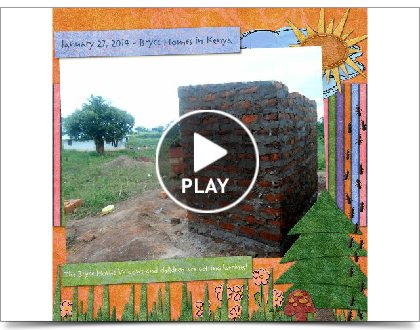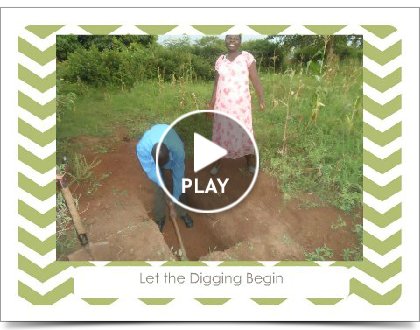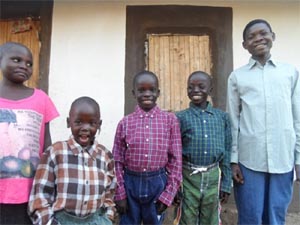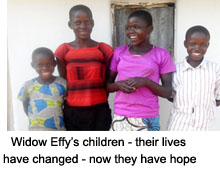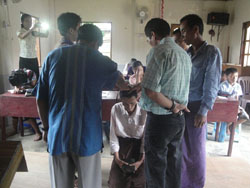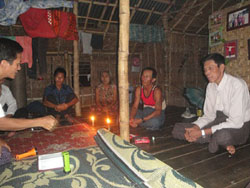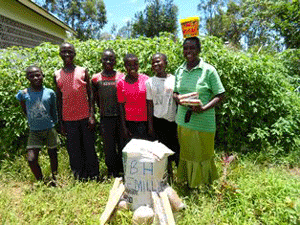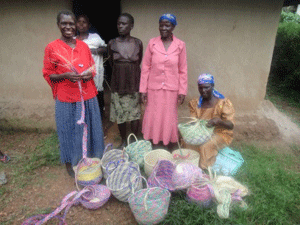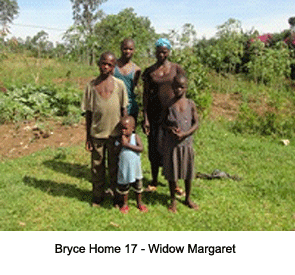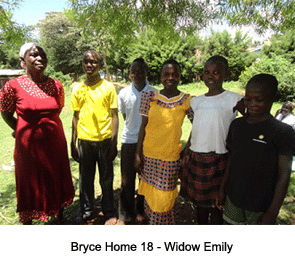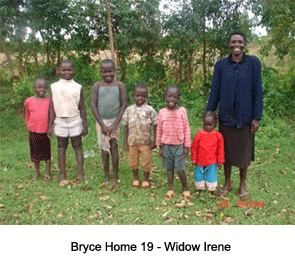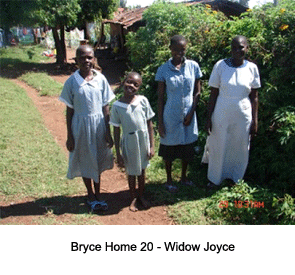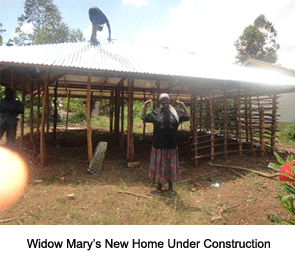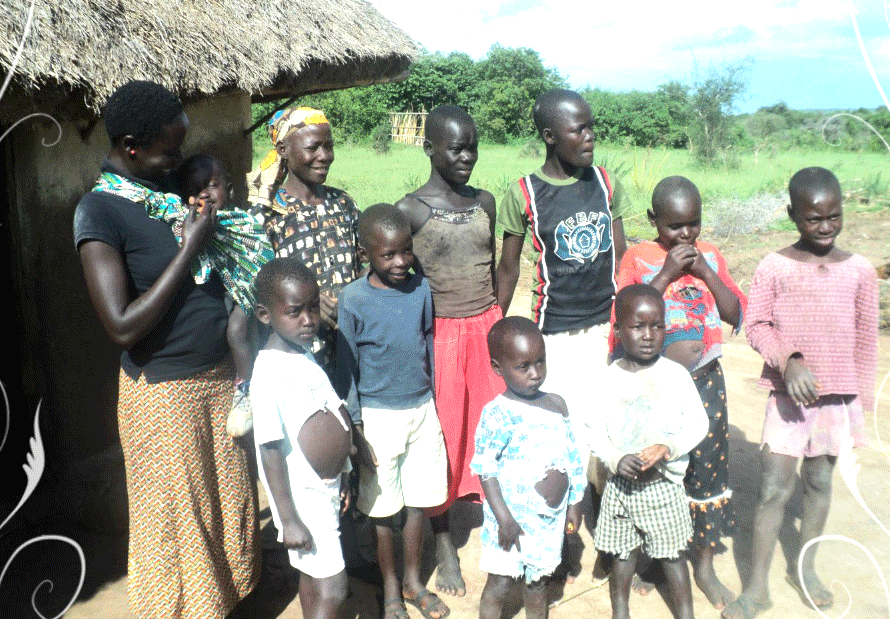Please scroll down to read all of the reports.
March 2014.
Report 11 Final Report
Another chapter of our Bryce Homes Kenya story relates to an amazing
transition that has occurred for Pastor Vitalis and his family who
have spent years in the Kibera slums of Nairobi living in deplorable
conditions and circumstances. I met Pastor Vitalis for the first
time when I arrived at the Nairobi International airport on my first
trip to Kenya in November of 2011. As I had a layover of several
hours before connecting with a flight to Kisimu, Pastor Achilla had
arranged for Pastor Vitalis to meet and help me make my connection
from one terminal to another.
Pastor Vitalis was my first contact with anyone from Kenya. He told
me about his experience living with his wife and large family in a
mud shack in the slums of Kibera. At the time, we were in the
process of considering expanding our Bryce Homes Program to Kenya.
He showed me a photo of where he lived and the number of children he
was caring for, most of them orphans whose parents had been killed
by the tribal massacres that had devastated Kenya as the result of a
recent political election.
We
had a meal together which brought up the topic of food. When I asked
him how he was able to cope with such a large family living in the
poverty conditions he had described, he opened up and gave me more
details. “At best, there is only enough food to have one meal a
day”, he said. Then he made a statement that I will never forget:
“We usually eat some rice or beans just before we lie down at night
so that hunger pains do not keep us awake.”
The following year on my second trip to Kenya when I was accompanied
by my friend Byron Hardy from Canada, our connection from Nairobi to
Kisimu was not scheduled until the following afternoon. This gave us
time to get some rest as well as an opportunity to meet with Pastor
Vitalis and his family in the Kibera slums. As his family had become
part of our program by then, I wanted to see for myself the
conditions they were living in and how we could help them.
Pastor Vitalis met us at our hotel, and after we hired a driver, we
headed off to the Kibera area, which was about thirty minutes away
from where we were staying. Finally we arrived and found a place to
park. Both Byron and I were somewhat hesitant about stepping out of
the vehicle. I have been to many slum areas before in other parts of
the world. What I was seeing with my own eyes this time was as if I
had landed on another planet.
We walked through
the winding trails over very rough terrain. It was difficult to
navigate the open streams of sewage that flowed everywhere. Garbage
was strewn everywhere although in a few places it was concentrated
in open piles. As Byron and I were the only white people in the
area, we felt somewhat conspicuous. Finally we arrive at the Vitalis
home. The door was a sheet that provided privacy from the outside
world. Inside there was another sheet dividing the mud hut into two
rooms. Byron and I were offered the two chairs that were in the one
room. We were asked to sit down and were offered a sliced bread.
The children crowded around, and the entire family was introduced.
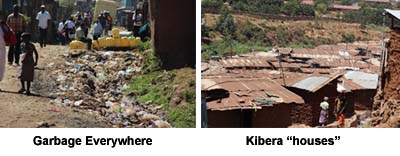
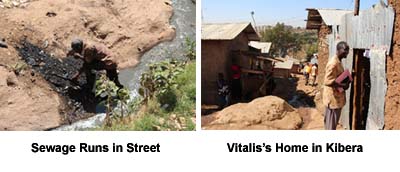
As
Pastor Vitalis had been part of our program for over a year, I was
able to ask him some questions regarding what differences his family
had experienced. As I looked around from the location where we were
doing the interview, a myriad of thoughts flooded my mind. While we
were attempting to come alongside and make a small difference, the
impact on the lives of this family was of paramount importance. Then
I thought about the area where we live in Canada and the United
States and the luxuries of life everyone takes for granted. Then I
thought out loud: if only I could transport some of the people who
live in abundance to this location so they could see, hear, and
smell the sights of the slums of Kibera. Wouldn’t they be willing to
invest just a cup of coffee per day to assist a Christian family in
need who lives in these conditions?
God
Answers Prayer
Moving Pastor
Vitalis and his large family of 16, which includes 10 orphans that
he and his wife provide care, has been on our list of things to
accomplish in Kenya for some time. When Lighthouse Trails and
Understand The Times decided to do a special fundraising program in
December of 2013 focused on adding latrines and new homes, moving
Pastor Vitalis and his family out of Nairobi became a priority. As
Pastor Vitalis was born in the Homa Bay area and grew up there, he
was known to the chief in that region. When he inquired about the
possibility of moving back, it was a matter of him making a trip to
see the chief and securing a deed for a plot of land.
Once the land was secured, plans could proceed with the building of
a home when funds became available. When our donors heard about this
need, they responded, and we were able to go ahead with
construction. Pastor Achilla
hired a builder to clear the property of bush and start the project.
When I arrived in Nairobi on my March 2014 trip, Pastor Achilla met
me, and we spent the night in a hotel. The following morning Pastor
Vitalis and four of his children met me at the hotel, and we
discussed the upcoming move to Homa Bay. They were enthusiastic
about the move, which should occur around the middle of April. All
sixteen children will be registering in a new school located near
their new house.
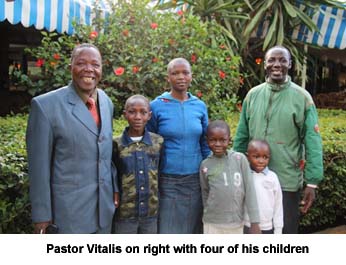
On
my final full day of touring the Bryce Homes,
we were able to start early in the morning and drive to the location
where Pastor Vitalis’ new house is presently under construction.
While we first travelled towards Homa Bay then northward to the
location by a paved road, eventually we branched off to a dirt side
trail. After what seemed like an eternity, we approached the site
where construction of the new Vitalis home was taking place. As we
got closer, I could see that the area looked like a paradise
compared to the Kibera slums where they are presently residents.
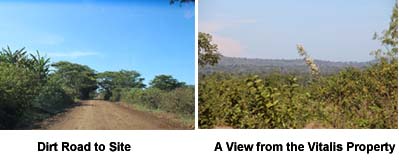
While Pastor Vitalis’ house is partially constructed, it will only
take a matter of another couple of weeks to complete the process.
Wooden poles are dug into the soil and provide the structure for the
walls. Smaller branches are attached to both sides of the vertical
poles. Metal sheets supported
by wooden rafters form the roof. Then water is mixed with dirt to
make mud that forms the walls and floor. Finally when the mud dries,
plaster is made from mixing cement, sand, and water, and the walls
and floors are coated. Windows and a single door are added, then the
house is complete.

When the house is finished, it will be painted inside and outside so
that it will be white. As well, a latrine/shower will be built on
the property, a cook stove and chimney will be installed, and
eventually eves troughs will be added to capture water off the roof
for storage in a large plastic tank.
The area surrounding the home where Pastor Vitalis and his family
will live is extremely fertile. Fruit and vegetables can be grown,
and livestock can provide meat, milk, and eggs. In the near future,
the family will be able to participate in a small business program
and work towards self-sufficiency. Pastor Vitalis can start a
Christian fellowship in the area and spread the gospel.

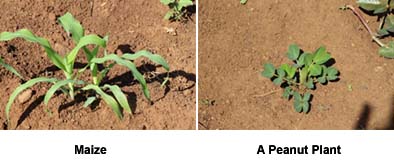
What a Miracle!
This transition from hell to paradise, from the Nairobi Kibera slums
to a fertile area near Homa Bay, from my perspective is a modern-day
miracle. While some may insist that miracles require demon
deliverance, being raised from the dead, or cured of a terminal
disease, the Vitalis family story shows me God can be involved in
changing impossible situations to bring hope and a real difference
in people’s lives. While this story is just one example, it reveals
how God is working in Kenya through the Bryce Homes Kenya Program.
This is God at work in a supernatural way using ordinary people and
ordinary circumstances.
Now think of this! There are also 23 other Bryce Homes in Kenya that
have their stories to tell. On this trip, I made the decision to
increase the number of Bryce Homes from 20 to 24. This means there
are now over 150 lives being impacted that can share testimonies
about the goodness of Jesus and the difference the Bryce Homes
Program has made to their lives.
Is
it possible this is only the beginning and that God has a plan for
us to share this vision on an even broader scale? As support is
provided from individuals and churches who seriously care about
missions, we are committed to follow the Lord, wherever and however
He leads.
Kenya
report 10
The
Miracle
The Bryce Homes in Kenya are not all
located in one concentrated area. At present, there are twenty of
them scattered in As you
can understand administering a program to widows and families in
such an expansive region is characterized by many difficulties.
However, this is how our Bryce Home Kenya administration team has
set up the program. This expansive outreach spreads out the support
and gives opportunity to share the gospel over a wide area. This is
the vision of the Bryce Homes Kenya program incorporated from the
beginning.
The families situated in the rural area are all located within a few miles of each other. The widows
and the children in this area are regular attendees of Pastor Achilla’s or Pastor Nelson’s churches. Delivering food to them is
not such a huge task. In every case, a vehicle carrying supplies is
able to drive close to the homes to make the drop off. In a few
cases, the driver has to make a detour from a trail and head across
an open field or pasture dodging the odd tree or large rock.
Delivery of monthly food supplies can be accomplished in several
hours.
To reach these eight homes all in one
day is a challenge. There are three major obstacles – the roads that
are not fit for vehicles, the cows and goats who share these trails,
and the weather. . From Migori, the road branches off and becomes a winding
trail where drivers do their best to navigate rock piles, cows, and
washouts that act as speed bumps and hinder speed beyond a few miles
per hour.

However, these goat trails, as I call
them, remain passable as long as it has not rained recently. There
is still another major hazard. My experience has shown me as the
result of several of these trips, if there are dark clouds forming
in the sky, you better be prepared for a flash flood as small lakes
of water and rivers form in seconds making your way impassable.
As it is not possible to carry
thousands of pounds of supplies on the backs of a few men to their
final destinations, the drivers are determined to transform their
vehicles into “boats” and treacherously proceed crossing huge mud
holes and small rivers.
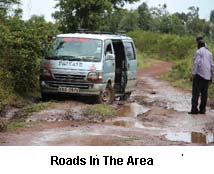
Finally, after encountering several of
these “near-stuck” experiences, the delivery mission finally reaches
its destination and the goods are dropped off. In some cases, it is
just impossible to reach the vicinity of the home by vehicle and
Nelson, Achilla, and Walter load the bags on their backs and carry
them by hand. On occasion, motor bike drivers come along and help
carry the supplies on the final leg. All in all, monthly deliveries are riddled with adversity and hardship and
always take more time than expected. If you start out at sunrise,
you can expect it will be after sunset
Perhaps as you read through this report,
you are asking the question: If there are plenty of widows and
orphans in more accessible regions, why would
you choose to travel into the wilderness into areas that are nearly
impossible to reach? I have to admit, after my first experience of
being shook up and thrown around in the front seat of a van for over
12 hours, I was asking the same question. However, now after seeing
what God is doing in these remote areas, I have a new outlook and
have grown to appreciate these widows who were chosen to be part of
the Bryce Homes Program because God is not a respecter of persons
including whether or not they live in accessible places.
In fact, it seems God is blessing the
widows because they have
suffered even greater hardship because of the location in which they
live. Pastor Achilla has felt a responsibility to assist widows and children who
have been left fatherless from the very beginning of the program.
I will never forget the first time I
visited Kenya. When we arrived in the area, we
were met by a large group of children and about twenty widowed
mothers who were singing songs welcoming us.
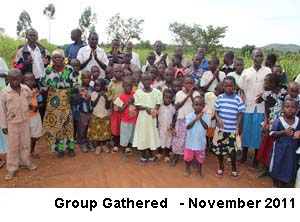
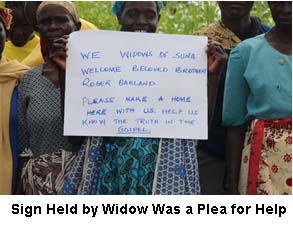
Most of the widows and orphans gathered
there that day had never seen a white person before. However, in
their desperation, they sensed that God had not forgotten them in
their misery and that possible help was on the way. While their
hopes and dreams may have seemed impossible at that time, we have
now seen God’s hands at work. Through Lighthouse Trails and
Understand The Times, donors worldwide have caught the vision and
assisted us so we have been able to supply food for eight families
on a monthly basis as well as build six new homes and six new
outdoor showers and latrines.
Testimony Show Miracles Have Unfolded
All six widows sponsored shared testimonies that revealed how thankful they are to God
for answering their prayers. Isolated in a remote area when they
were forced into a situation to look after their children alone was
an unbearable situation. Because other families living in the
community were as poor and desperate as they were, there was no way
to reach out and ask for help.
Chief Jared, who oversees the community,
made a special trip and followed us around as we visited
each home. As an appointed representative to the community by the
Kenyan government, he told us that what he has observed and reported
is being discussed by many other communities and true Christianity
is being observed in action.
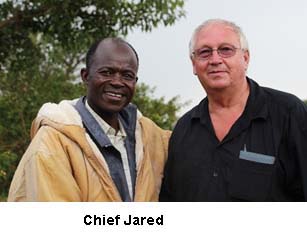
Future Projects
As previously reported, there are a
number of projects we are praying about for the Bryce Homes Program
in Kenya. These include capturing water from roofs in storage tanks,
water treatment in order to purify drinking water and implementing
small business opportunities so families can work towards
self-sufficiency. This will make a huge difference and will
open up the possibility that more widows and orphans can be added to
the program.
As well, we have a plan to add a
pastor/evangelist devoted to teaching the Bible and being a
spiritual leader for all of the families in the area. In the near
future, we have plans to build a small church so that families can
gather to worship. By a church, I am not referring to an elaborate
building with stain-glass windows and a paved parking lot.
A wonderful miracle is underway. May God continue to pour out His blessings as the
months go by as prayers continue to be answered and the gospel
continues to be spread. My heart has been touched by what I have
seen and heard and am committed to tell others so that they know
about the good work God is doing through the Bryce Homes Kenya
Program.
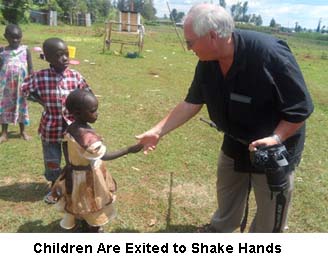
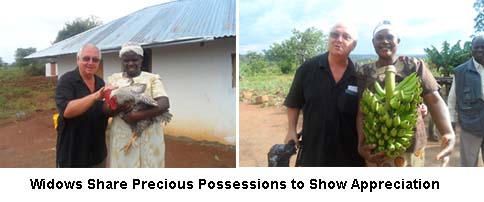
Report 9
Helping
Widows to Become Self-Sufficient
Life in Kenya is difficult enough.
However, when a mother who has several children loses her husband to
the ravaging disease known as AIDS (or some other all-too-common
disease in Africa), her life becomes a horror story. Imagine if you
can what happens when the man who fathered your children and
provided food and shelter for your family suddenly dies and you are
left alone. How does a widowed woman, who barely survived before
the death of her husband, continue to live and support her children
when she is on her own? Can you image the despair and hopelessness
that overcomes her?
Families with widows as the only parent
brought about by AIDS makes up 60% of the population according to
one government official I met from the North Kadem area. Worse yet,
in many cases both parents have been wiped out by this disease and
grandmothers who are also single are called upon to raise their
grandchildren. They have no income, no food, and no way to make
their quality of life better.
While there are government agencies and
global fundraising organizations dedicated to looking for solutions
to the problem of AIDS, the fact is, there are a myriad of widows
left helpless in dire situations. Families go to bed every night
hungry and crying for food. The clothes they wear are nothing but
torn rags. They huddle under thatched leaky roofs when it rains and
shiver on mud floors without any mats of blankets so that sleep is
impossible. Such is the life of countless fatherless families who
belong to the family of God and the body of Jesus Christ in Kenya.
The widows that God has called us to reach out to and care for are all
Christians. When we met them, they were regular attendees of Pastor Achilla’s church or cared for by associate pastors who volunteered
their services to care for those more needier than themselves.
Pastor Achilla is well known in this region, not only as a man of
God but a man who has great compassion for the poor and needy.
Whenever and wherever I have traveled with him, people approach him
and greet him. He is a true pastor that makes people a priority and
loves and cares for those in need.
Before we partnered with Achilla and his
team, he was already doing all that he could to encourage widows.
Numbers were being added to his small congregation on a weekly
basis. The burden to minister to their needs seemed like an
insurmountable and overwhelming task.
It was this attitude and vision that
caught my attention in November of 2011. The Bible encourages
members of the family of God to reach out and care for widows and
orphans and respond accordingly. In the book of James, chapter one
and verse 27, we read: “Pure religion and undefiled before God and
the Father is this, to visit the fatherless and widows in their
affliction….”
Such a concept is a foreign idea for
most churches and church leaders today. Their concept of spending
the resources they have been given by their supporters usually goes
towards buildings and empires that can be seen as marks of success.
Missions programs that invest in lives far away are not good
“business” decisions. “Real religion” in the modern world has turned
God’s Word upside down. It is more about “more for us” and less and
less for others. Widows and orphans are forgotten about and ignored.
This westernized mentality that drives
the purpose-driven, church-growth mindset has always troubled me.
For years, I thought and prayed about how this could be changed.
Then there was a breakthrough. As our ministry was in the process of
moving towards our Bryce Homes International Program that was born
in 2006 in memory of my son Bryce, it seemed that a partnership with
Pastor Achilla and his team in Kenya would be a perfect fit to
fulfill God’s calling upon my life. This partnership, which later
expanded to include the promotion by and support of Lighthouse
Trails, has now proven itself for over three and one half years.
The Road from Dependency to
Self-Sufficiency
However, when God is truly in the lead,
one never stands still or in one place. God is almighty and sees
what is best and the steps that are required to move on. While the
Bryce Homes Program has been a great success, there has been a
question or concern that has been consistently at the forefront of
my mind. While food has been provided on a monthly basis along with
clothes, homes, and latrines to make life easier, there was
something missing.
The purpose of designing the Bryce Homes
Program was never to become a welfare agency by becoming a
never-ending pipeline guaranteeing assistance perpetually so that
entire families could grow up depending on others instead of helping
themselves. Such a system, in the long run, would be harmful and
destructive. I pondered. There had to be a better way so that
through time a transition could be made from total dependency to
self-sufficiency.
One of the main purposes and objective
of my March 2014 trip to Kenya was to investigate the possibility of
adding another dimension to our program. I wondered if any of the
widows had ever thought about small businesses they could start that
would subsidize the support they were receiving through the Bryce
Homes Program. The results were delightful. Every single widow that
I interviewed immediately responded to the question. I have many of
these responses recorded on video and will later publish the report
as a short documentary.
What surprised me was the fact that none
of the widows had to think about the answer to my question, even
though they had not been told beforehand what question I was going
to ask. Every single widow already had prayed and dreamed about a
time in the future she could set up a small business and not have to
rely upon donor support. In fact, many of the women had previous
experience with the small business they were desiring to start
before their husbands had passed away. The death of their husbands
had not only left their children fatherless and without their main
source of income but also the widow herself, who had been a
secondary bread winner, was no longer able to continue as all her
efforts had to be concentrated on helping her children survive.
When you see and hear the responses the
widows gave me when I told them about the coming Small Business
Opportunity Program, you will discover for yourselves why God has
been leading us in this direction. For now, I will show a photo of
the widow and then briefly describe what kind of small business she
wanted to do.




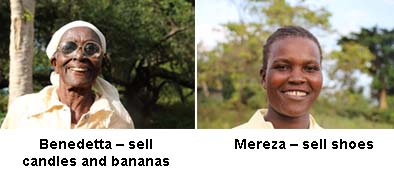
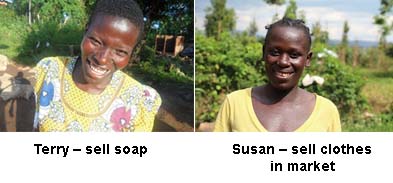
Small Business in Kenya
I must say that I was somewhat surprised
by the entrepreneurial enthusiasm I sensed from these ladies who
range in ages from 25 to 75. The concepts of making, buying,
growing, and reselling were not new to them. For most of them, they
or their parents had small businesses at one time in their lives.
This is what life is all about in Kenya. This is how people survive
and make a living. When a widow becomes a widow, she not only loses
her husband, she also loses her potential to have a job. Worse yet,
she knows that she becomes a liability to the community rather than
an asset.
Knowing what I now know and seeing the
countryside through eyes that have been opened wide, a flood of
ideas and thoughts have poured into my mind. There is now a way to
move on and start small business experiments one by one. It is not a
matter of purchasing or renting buildings or forming a corporation
with a fleet of cars or hiring staff. Each widow and her family can
establish her own business right in the area where she is located.
The widows may have to rent a “piki-piki” from time to time to catch
a ride to the bigger markets where they will secure the goods they
are going to resell, or they may have to set up a temporary “Kiosk”
or display table. Although these costs are next to nothing in our
standards, for them a penny is more than they can afford. What they
need is “seed capital” to get started. Once they get going, their
own creativity, coupled with hard work, perseverance, and good
business practices, will become their lifelines to the future.
How Many Products are
Sold
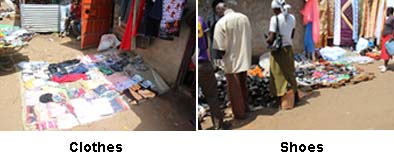
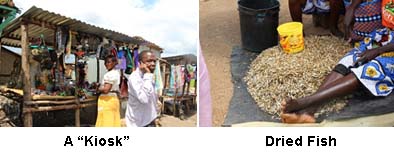

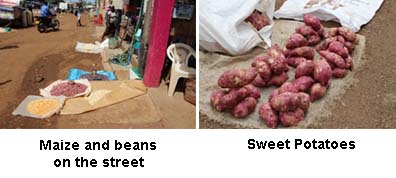
Supporting Small Business is a Positive
Solution for All
I see the small business program as
having many positive benefits. While developing a small business,
the whole family will participate and reap the profits in several
ways. Rather than growing up expecting others to provide for them,
the children will learn principles that come along with working hard
for a living, and then this knowledge can then be passed on to the
next generation. One of the requirements we will teach and enforce
is accountability. Financial records will be kept and overseen as a
way of measuring the progress and success of the program. We are
already considering one of the widows to oversee records and
encourage the women.
Now, think of this. What if these newly
founded widow-entrepreneurs were to add another dimension to their
lives and develop into widow-evangelists impacting the people and
locations where they buy and sell their goods. A number of them plan
to walk around their neighborhoods and play the role of door-to-door
saleswomen. What a perfect opportunity to share the love of Christ
and tell others about the good news and become door-to-door
evangelists.
I am convinced this idea to assist our
widows to start up small business programs has been inspired from
above. In the future, we will be establishing a special project and
letting you know what will be required to assist with the startup
funds. While this figure has not been determined as yet, the amount
is expected to minimal. If you are a business man or business woman,
you will understand most businesses start out with an idea and then
through time have the potential of growing. What would happen if
some of our widows were eventually able to support themselves and
even consider helping others less fortunate than themselves?
Like James stated under the inspiration
of the Holy Spirit, genuine or real Christianity is demonstrated
when Christians are given the vision to support widows and orphans
rather than being consumed with ourselves. I pray that God will use
this program in order to touch many lives that will count in the
present and for eternity.
Kenya – Report 8
Video Update From Bryce Homes Kenya. Showers and Latrines that were
built as part of the Winter Offering Building Program.
Living Water for Kenya
You don’t need a scientific mind to
understand that water is one of the main essentials for life. In
fact, a primary foundation of basic biology is the declaration that
without water there is no life. The Bible also uses water as a
comparison when discussing the quality of spiritual life and
following Christ. Jesus said, “He that believeth on me, as the
scripture hath said, out of his belly shall flow rivers of living
water” (John 7:38).
For those who live in technologically
advanced parts of the world, it is hard to even imagine what it
would be like to be limited by water in any way. If we are thirsty,
we turn on the tap or go to the fridge and grab a cold bottle of
water. We shower or bath daily, flush our toilets, and water our
gardens and flowers without hesitation. Seldom does anyone ever
consider what it would be like to be in a situation where water
would be a limiting factor or worse yet even a threat to living. The
availability and quality of water is a given for most who are
reading this article. We consider this common necessity for life a
God-given reality that we deserve.
The
Outcome of Unclean Water
A trip to rural Kenya can be an
eye-opening experience for someone like myself who has never had to
struggle to access a plentiful water source for daily needs and
especially good clean water to drink. The list of problems and
potential disasters that face the people associated with water
sources or lack of sources can be very discouraging in Kenya. The
only running water that can be found is usually in a muddy,
insect-infested stream.
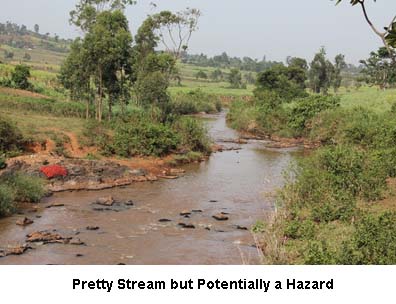
While boreholes, also called wells, can
be dug, if water is found, it is sometimes salty and not fit for
human consumption. The digging of wells is costly as it is done by
hand, and the depth they must be dug is often very deep. Often the
well is dug in vain, and even though the funds have been spent,
there still remains no water source.

Wells have been dug
and water is accessible throughout most of the year. However, many
different families access the water from these boreholes by dropping
down pails attached to a rope. The pails are often dirty and full of
germs. Walking on the surface of the well are cows, goats, donkeys,
and chickens that deposit fecal debris continually. It is
questionable whether or not
the water is any safer to drink
than in the country.
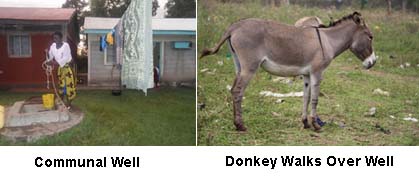
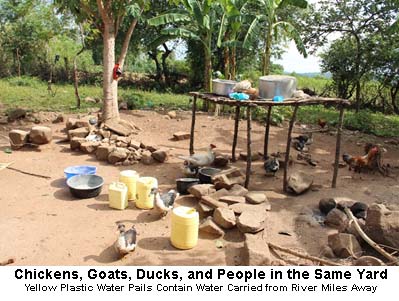
The biggest problem with water, when
water is found, is that it is one of the leading causes of sickness
and death in Kenya. Most people living in rural areas do not
understand why they are sick and have no way of finding out as they
cannot afford medical care. In other words, their bodies are
constantly fighting some life-threatening situation; they don’t know
what it is and they have no way of getting help to get rid of it.
What a miserable way to live.
During my trip to Kenya last week, my
driver, Steve, informed me that contaminated drinking water in Kenya
is perhaps the most significant problem that rural people face.
Coupled by the lack of education and an understanding of the cause
of disease, they often equate the illnesses acquired from infected
or contaminated water as “dark spirits” that are harassing them
because they have done something wrong. While our Bryce Homes (which
are run by Christian believers) are not vulnerable to this type of
mentality, which comes out of tribal customs and beliefs, they still
are subjected to the illnesses that come from unsanitary conditions.
Dysentery is the normal response and is considered normal.
However there is much
more for widows, orphans, and all others to deal with. Some of the
waterborne diseases acquired through drinking contaminated water as
listed
(http://www.indexmundi.com/kenya/major_infectious_diseases.htm)
include:
Hepatitis A - viral disease that
interferes with the functioning of the liver; spread through
consumption of food or water contaminated with fecal matter,
principally in areas of poor sanitation; victims exhibit fever,
jaundice, and diarrhea; 15% of victims will experience prolonged
symptoms over 6-9 months.
Hepatitis E - water-borne viral disease
that interferes with the functioning of the liver; most commonly
spread through fecal contamination of drinking water; victims
exhibit jaundice, fatigue, abdominal pain, and dark colored urine.
Typhoid fever - bacterial disease spread
through contact with food or water contaminated by fecal matter or
sewage; victims’ exhibit sustained high fevers; left untreated,
mortality rates can reach 20%.
Then on top of this, add the parasite
factor. Parasites can affect every organ in the body and cause
horrendous damage and trauma. All of these things seem unfair and
certainly unbearable. Such is the price one pays to live in a
beautiful land plagued by poverty and disease that is accompanied by
the lack of means to do much about it.
Based on my limited experience
travelling around visiting our homes and speaking with my drivers
and the Bryce Homes Kenya leaders, the symptoms described above are
manifesting constantly with the people we are attempting to help. If
these people remain subject to this same problem of contaminated
water on a continuous basis, the problem of poor health will only
continue, if not get worse. Although we are providing food,
shelters, clothes, and good latrines, all of this soon becomes
meaningless to someone who is dying from a disease caused by
contaminated water.
Water Collecting and Water Purification
As we have previously reported, in an
attempt to make the quality of life better, we have already
constructed 12 new Homes for our families with metal roofs to keep
them dry when it rains. On my March 2014 trip, while travelling from
home to home, a sudden revelation popped into my mind. If the
metal roofs are doing the job of keeping our people dry, then why
not collect or capture the water that is shed by the roofs in a tank
so it can be used. Actually after the idea came to me, I
wondered why it had taken so long. When I was a young boy living on
a farm in Canada, this is how our family collected water for washing
and other daily practices.
When it rains in Kenya, it really pours.
At particular times of the year, the certainty that there will be an
afternoon downpour is 100%. Why not collect this water for human use
rather than letting it fall on the ground and then run away. Sure
enough, my idea was not new as later I noticed that some of the
schools in the area were using this concept.
So here is step one. We will start with
the Homes that are in the greatest need. Some are miles away from a
well or from a river. How much more convenient it would be to have
water just around the corner – the corner being one of the corners
of their own house. Lawrence, who does construction work (assisted
us in the building of the latrines) has looked at the situation and
has already come up with a plan. He is also capable of doing the
eves trough (gutter) installation. After this is completed, we will
construct a solid elevated base at one corner of the house where a
plastic storage tank can rest and be secured. Every time the rain
falls, water will be collected thus providing at least one good
source of water for daily use.
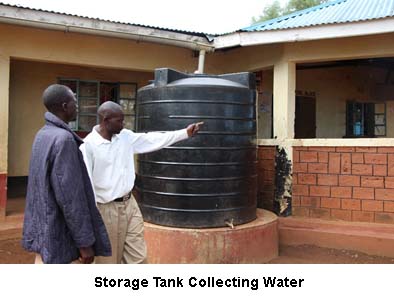
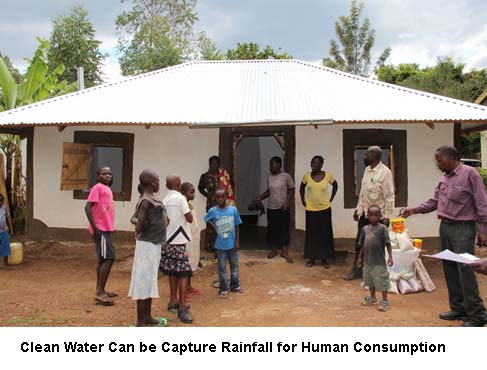
In the
near future, we will be obtaining quotes regarding the costs to
assemble this simple yet vital way of trapping water. We will start
with a few and see how this works. If successful we will add more as
time goes by.
Purification of water for drinking purposes is an absolute necessity
if we are going to improve the quality of life for the families we
are supporting. It is a matter of doing some research, finding the
proper device, securing the funds, and then putting this project
into place.
When we
have done this, we will be putting together a water collection/water
treatment program similar to the latrine program.
When we
told several of the widows that we were considering a program to
help them with their needs related to water shortages and purity of
water, they all were joyful. Later I will be documenting these
interviews by producing a short video to post on our web site and
YouTube.
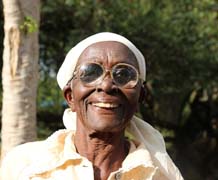
Widow
and grandmother Benedetta was even more than ecstatic. As soon as
Pastor Achilla translated so that she could understand what I was
saying about the coming water project, she broke into a dance and
started to sing. “Praise God, Praise God, Hallelujah. Amen and
Amen,” she squealed at the top of her voice. Then she broke into
tears, “My knees get so sore now when I carry the buckets back and
forth to the river for the water for cooking, drinking, and
bathing.”
I looked
over and saw the pails she was taking about on the ground.
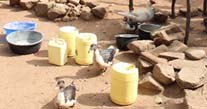
Water
Evangelism
So if
Jesus proclaimed that believing in Him was the key of life and that
“living water” would flow from us so that we would be a spiritual
influence on others, what about the idea that the provision of
natural purified water for those who are in need could also be a
tool to share the gospel? Is it possible that sharing the good news
of the gospel can go hand in hand with sharing physical water and
making it pure to drink?
While
true biblical Christianity must never confuse the true gospel with
the “social gospel,” the true gospel recognizes that while the
spiritual condition of a people is supremely important, their
physical welfare cannot be ignored (see James 1:27; 2: 15-16). If
food, clothes, houses, and latrines show that God cares for those in
need, what about water, the most important and basic component of
life?
Maybe
those who have been given this pure water as a gift from brothers
and sisters from around the world who care for them can share this
precious gift with friends and neighbors who are not yet believers.
Thus, the fulfillment of Jesus’ own words will become a reality in
Kenya – believers in Christ will be filled to overflowing with
spiritual water that they can share with their neighbors as they
endeavor to evangelists for Christ.
While secular
organizations also recognize the importance of assisting the poor
and needy with the procurement of clean water, they lack the leading
and direction of the Spirit of God and the Word of God. My prayer is
that our Bryce Homes Program in Kenya will always be led by the Lord
in the truth of His Word and that it would always proclaim the
Gospel foremost. I pray we will develop a water collecting/cleansing
program that will bring glory and honor to Jesus Christ. Lord
willing, may we become known as a Bible-believing organization that
leads the lost to Jesus by using “water evangelism” as a witnessing
tool.
Report 7 Kenya
New Homes and New
Latrines
I have never been enthusiastic about short-term
missionary work that uses the “drop and run” method of handing someone a gospel
tract then heading home never to be seen again. While God can use any method or
technique to plant seeds of truth that later can be germinated by the Holy
Spirit to produce good fruit, God has led Understand The Times in a different
way. The way this has happened is truly a God thing. We did not come up with an
idea or method and then put it in action by human means. By simply being led by
circumstances divinely appointed, we came alongside nationals who are already
strong believers and discovered they had a desire to reach their own people but
lacked the means to do so.
This is exactly what has happened in Kenya. While
Christianity in Africa is tainted (to put it mildly) with “every wind of
doctrine” known to the Body of Jesus Christ (largely thanks to Western
teachers), the contacts to whom the Lord introduced us were not only like-minded
and grounded in the Word, they demonstrated themselves to be ministers of the
gospel who operate with accountability. This is the first prerequisite that must
be fulfilled in order to put together a team for implementing a program with an
organization that is based halfway around the world.
As I have mentioned previously, the obvious lack of
food required for nutrition for orphans and widows was the first indication to
me there was a physical need that had to be addressed if we were going to be
effective as ministers of the gospel in the country of Kenya. How do you tell
someone about the wonderful salvation provided by the grace of God when each
evening he or she goes to bed with hunger pains so intense sleep is not even
possible? While those of us who live in developed countries have no idea what
this kind of experience would be like, for the poor and desperate in Kenya this
is just everyday life.
Further, while in the areas we are attempting to
reach there is the possibility of producing food such as maize, beans, and rice,
widows who have been left helpless by the loss of their husbands also have a
problem with the lack of regular water supply. They are held captive by a
hopeless situation. Since nutrition is one of the main factors relating to
health and growth, illness is common place in Kenya. This further adds to the
woes of fatherless families who are attempting to cope with life.
The first phase of our outreach program in Kenya was
to provide nourishment to the families we incorporated into our program on a
monthly basis. This is done as our three leaders purchase the food in bulk, pack
it in bags according to the size of each family, and then deliver it by hiring
drivers and rental cars.
The supplies not only include rice, maize, and beans
but essentials for cooking including salt and oil. Soap for washing and cleaning
bodies is a luxury that most had never experienced, but now they have this too.
The next phase was to provide blankets, clothes instead of the rags they were
wearing, and mattresses for the widows so they did not have to sleep on the mud
floors.
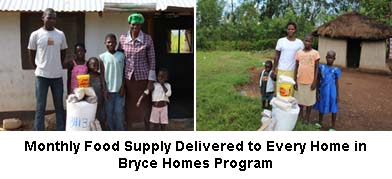
While the food problem was being addressed, it soon became
apparent that the majority of the shelters our widows and families were dwelling
in needed to be replaced. The typical conventional huts that Kenyans build in
rural areas are made of mud walls and thatched roofs. Their durability to the
weather is not long lasting, and they soon become leaky shacks not fit for
humans.
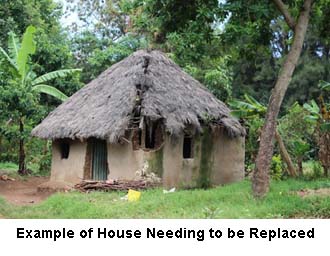
Following my second trip to Kenya in March of 2012,
we asked Pastor Achilla and his team to secure bids for the construction of a
few new homes. Understand The Times and Lighthouse Trails shared this need with
our readers. First one home was built covered by a metal roof with four rooms
instead of the typical two, the walls were painted white inside and out, and a
stove was added in one of the rooms for cooking. These stoves
were designed in Kenya. They have a chimney, which vents the smoke outdoors
alleviating another major health problem.
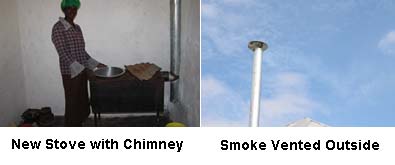
To the present date, twelve new homes have been
constructed, These homes have
become a landmark or a trademark for the Bryce Homes Program. As these
plastered-painted-metal roof-with chimney houses are popping up everywhere, the
word is being spread that God has not forgotten the poor and needy in Kenya.
Government officials are taking notice and expressing their gratitude for the
program, asking our leaders how it can be expanded further.
Now families can sleep at night and not fear their
roofs will fall in on them or that a downpour during the night will force them
to cover up with a plastic sheet. No longer do they have to inhale smoke that
damages their lungs nor do they have to worry about their shelter catching fire
as they sleep. While we have assisted in supplying beds and furniture, more
furniture is needed. Keeping with our motto “As the Lord makes a way, we will
move one step at a time.” The needs are so great we recognize our limitations
and proceed with caution.
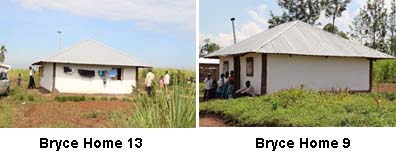
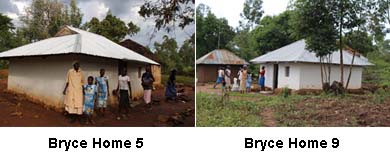
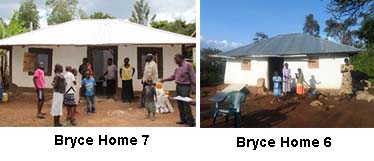
So far, I have documented several of the steps that
have been made in order to establish the Bryce Homes Kenya program now impacting
a country for the glory of Christ. For myself who has traveled to Kenya four
times to monitor the progress, I have found a number of signs or indicators that
have shown me God is leading us and that this is a “work of God,” inspired by
God, and for the glory of God. The smiles on the faces of the widows and the
orphans who are now accustomed to seeing a white man who has come from a
far-away tells me and our Kenyan leaders that their faith in God has grown leaps
and bounds since my first trip in 2011.
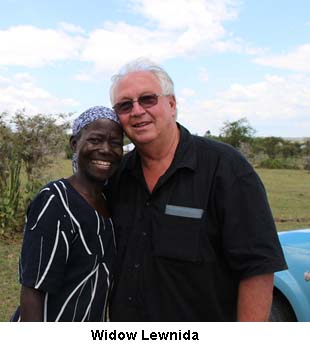
Adults and children are sharing their faith with
others who are asking them, “How can the changes that have happened to you be
possible?” They have observed that God has noticed them in their misery and has
answered their prayers. They have been removed from their pit of despair and
given hope, and now they are looking for ways to be a blessing to others who are
still less fortunate. People around can see that Christianity is not a belief
system just based on mindless emotion and hype. They see a practical display of
the Christian faith that provides a plan by those who have the means to assist
those who have nothing in the name of Christ as a demonstration of a real faith
that makes a difference in the world. Many, because of their observations, are
asking questions about how one becomes a Christian. Others are powerfully
seeing the hand of God and are coming to know Jesus Christ. Achilla’s church is
growing, and there are plans to plant more churches in surrounding areas.
While food, clothes, stoves, furniture, and homes
have been stepping stones to faith, perhaps the most significant project that
has made the greatest difference is a project I never would have expected. On my
last trip, Pastor Achilla pointed out to me the reason so many were sickly was
because there was a need for outdoor latrines for the deposition of human waste.
This may sound strange for us based on our western culture, but it is a fact of
life in Kenya. We only know about the conveniences that go along with hot and
cold running water – toilets and showers. Few have ever experienced the use of
the raw outdoors when the call of nature comes on a daily basis.
Not so in rural or even urban Kenya. The nearest
bush, patch of weeds, prickly sugar cane field or behind the biggest rock in
site is the location where one retreats for relief. Basic hygiene dictates that
such practices soon lead to disaster when body wastes are not confined and
isolated. So necessary action became apparent – something needed to be done to
find a way for this problem to be solved.
So Pastor Achilla, Pastor Nelson, and Walter were
asked to do the research. Lighthouse Trails and Understand The Times informed
our readers of the need. Thus the Christmas/Winter 2013 Building Project was
born. When donors found out about the project that would construct latrines for
all our families the funds poured in from all over the world.
Deep holes in the ground were dug, brick walls and
partitions were built and plastered, cement floors were poured, and finally
metal roofs completed the frames. These small buildings were also designed to
have a second function. A second compartment complete with a door, provided
privacy for an enclosed shower.
Finally, came the last and most important feature.
The first latrine was built with the typical “hole” in the floor. Apparently,
that is the way it has always been done in Kenya. However, because of our North
American point of view, the Bryce Homes Winter Construction Project established
a new precedent and initiated a new style of latrine so that one could sit on an
elevated seat.
While you may be bewildered why I would even
consider mentioning these details, there is a definite point. What I discovered
while visiting each home and interviewing the widows is that all were verbally
ecstatic about the latrines and how they worked. The new style was an absolute
hit, especially for the older widows.
In fact, the latrines have now become a major factor
that has developed into another evangelistic tool for the Bryce Homes Program.
Neighbors who come by to visit want to see the “new thing” that has come to
Kenya. Private showers and “sitting” toilets have developed into a major
witnessing tool. Who would have believed that a latrine could bring such an
unexpected result?
Video Update From Bryce Homes Kenya. Showers and Latrines that were
built as part of the Winter Offering Building Program.
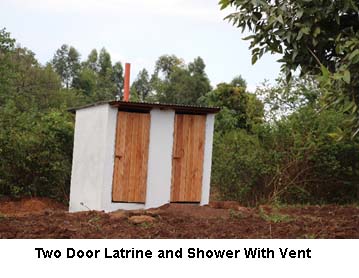
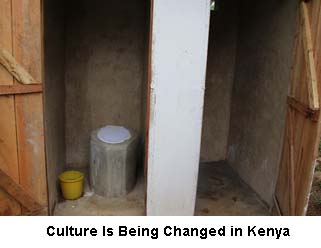
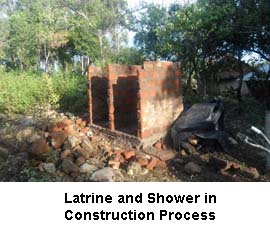
While visiting the area this time, I met with the Chief
of the region. He had travelled there by motorcycle especially to meet me and
thank me personally for the difference the program has made for the community he
oversees. (I have his interview on video tape, which I will be sharing at a
later date). The one thing he was emphatic about was the difference the latrines
had made to the widows in the area. “No longer do they have to go and hide
behind a bush when they are showering,” he said. “Now these women can live a
life that gives them dignity,” he further declared. “Your contribution to our
community has made my life easier. I am most grateful and thank the Almighty God
for your coming to Kenya.”
It was obvious to me as we visited the homes in the
area
the difference there was in the way I was accepted since my last trip. The love
and gratitude expressed to me was very obvious. It was like I had become part of
their culture and that they understood how much I cared for them as human
beings. (Again, at a later date I will put together a video that will share
these comments).
To demonstrate their appreciation I was given four
chickens by four different widows topped off by a huge bundle of bananas by a
fifth widow. Knowing how little these widows have and what they gave, I was
reminded of the story of the widow in the Bible who had virtually nothing, but
all she had, she gave to Jesus.
I am certain now that the houses, showers, and
latrines that have been constructed through the support of our donors have made
a tremendous difference. Only God knows where this will lead in the future. I am
praying that I will be given the opportunity to return to Kenya again to see.
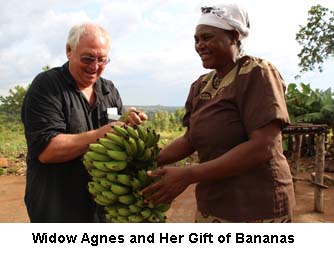
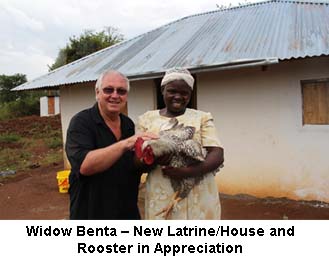
Kenya Report 6
Bryce
Homes Kenya: Past, Present and Future
The reports we have been posting on our
website about our March 2014 Bryce Homes Kenya tour until this point
have been brief and centered on specific events. For the ones
remaining, my plan is to provide more background information and
develop the topics. As you will see, the remaining reports will be
more like a small chapter for a book, that Lord willing, will be
published sometime in the future.
One thing I need to say in this
introduction is that missionary work in any country or place around
the world must be a calling, not a job. Missionaries cannot be
“driven” by some organized plan by man. They must be called, hear
the call, have a compassion for the lost and needy, and then
respond.
Further, missionary work must never
compromise the gospel of Jesus Christ or ignore or water down the
Word of God by incorporating a montage of religious beliefs. The
Bryce Homes Program worldwide from its inception has been dedicated
to reaching out to the poor, especially orphans and widows, by
coming alongside and supporting national Christian leaders to
administer physical support and spiritual guidance.
This is exactly how and why the Bryce
Homes Kenya Program was born. When I first visited Kenya in November
of 2011, I was not specifically searching for another project or for
more work for our small non-profit organization. In fact, this came
at a time when most of our church support had abandoned and shunned
us following the position I took on the emerging church through the
publication of Faith Undone.
However, what may have been meant for
harm and discouragement, God redirected for His glory. While
“church-growth corporate programs” encouraged by pastors with
“church-growth mentality” continues to “drive” congregations to
build bigger kingdoms here on earth, God has allowed me to move on
and away from their plans and follow His leading. We are not
interested in kingdoms built by man. We want to be conduits that God
can use to serve others by meeting needs in hopeless situations
while being ambassadors for Christ and the gospel of Jesus Christ.
So far, the countries of Myanmar, Kenya, South Africa, and the
Philippines have been the areas where we have been led to establish
Bryce Homes Programs by the Holy Spirit.

The
Growth of the Program in Kenya
Every missionary endeavor in which I have had the
opportunity to participate has begun with a small idea. I have
learned that in missions, ambition is not the key to success. Nor
is the size of the program a means to measure what is important and
what is not. Our God is the One in charge, and He is the One who is
building His Church. We are only His hand extended as we walk in His
will.
As someone with a science background, I
have been trained to make observations, and in the case of
missionary work, it is important to identify the needs and then see
how they can be met through limited resources. When we have shared
these needs with others through reports or live presentations, God’s
people have responded generously.
While a few pastors still have a heart
for missions, their churches are usually already supporting others
they know or believe in. Usually these are small churches that are
struggling to exist. This is how God works. Being a missionary
should not be a competition to see who can be the best fundraiser.
We have not appealed for church support although we are blessed and
encouraged when that happens. God has shown us there are individuals
all over the world who are desiring to invest financial resources in
a Christian-based organization dedicated to truth and integrity
while these donors disperse their hard-earned funds for the cause of
missionary work.
At this point, it would be helpful to
show group photos of all twenty Homes, which by the way, I was able
to capture on March 2014 trip. However, for now I will provide
photos of a few.




One of my purposes for this trip was to
document the numbers of children supported by each home to make sure
the support we are sending each month to purchase food is
sufficient. I was startled by what I discovered – 16 widows, 123
children plus the husbands and wives from the four Homes established
by our Bryce Home leadership which makes another 8. This means that
presently there are 147 human lives that are benefiting from the
support we send every month.
As the program is never static, there
are always needs that we address from time to time. So far, the
Homes we have added have a connection with Pastor Achilla’s Church
in some way. Widows and children attend but the church does not have
the financial means to provide for their care. This is where
Lighthouse Trails and Understand The Times have been able to play a
role. We have made the needs known, and God’s people have responded.
Some may be wondering what are the
approximate costs to provide monthly support for each of the 20
Homes in Kenya each month? Remember, there are also costs that we
must factor in for the expenditure of delivering the supplies by
hiring drivers and the small honorariums that our leaders receive
for their hard work. According to my calculations based on all the
information I have gathered on this trip, the amount per Bryce Home
works out to be about $150 per month.
Aside from the monthly support costs,
the program has funded the construction of 12 new homes and 16
latrines that I will mention in a later report. Rather than ask for
individual specific support to sponsor specific children as we have
for some of our Bryce Homes in Myanmar, we have found that this is
too time consuming for our small organization that operates with
mainly volunteer help. While all support designated to Bryce Homes
Kenya goes to these costs which I have outlined, we are considering
looking at an option whereby supporters can adopt an entire Bryce
Home or as in the past designate the funds to specific purposes.
The
Future of Bryce Homes in Kenya
The reason I am proposing a change
is that while I have been here on this trip, I have become aware of
the need and possibility of establishing four new Bryce Homes,
bringing the total to twenty-four. Two of these Homes will be widows
and their children – Widow Florence and Widow Beatrice. Widow
Florence
is already actively ministering to the other widows by praying with them and encouraging them. She will also play
an active role in administering and overseeing the Small Business
Programs we will be assisting the widows with in the near future.
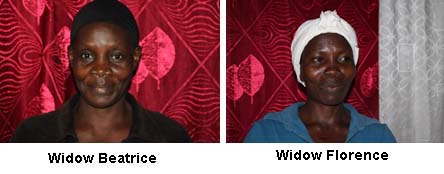
Another idea that was derived from this
trip relates to the vision God has given us for Myanmar in that we
provide Bryce Home assistance to pastors and evangelists with
families. These diligent workers, although they work to provide a
living for their families, are not able to make ends meet. As well,
they have filled the corners of their homes with orphaned children
who have come to them pleading for help.
As I have been strongly convicted, our
support to them will accomplish our two main goals – providing for
the needy as well as helping build up more ambassadors for Christ
that will be impacting Kenya. One is Pastor Lawrence who was the
person in charge of construction of the 16 latrines that we recently
built. The other is Pastor Dan.

At a later time, we will be publishing
their testimonies, telling you more about their families, and making
it possible for their sponsorship.
For now I will conclude this report. As
usual, over these past days, I have been waking up early in the
morning desiring to record in writing the recent images and ideas
that have been burned into my heart so that others can share them
with me.
Obviously, not everyone is called to be
a missionary. I had no concept as a young Christian thirty-five
years ago that my final years of this earth would be devoted to such
a cause. However, God has a way of directing and redirecting our
paths, especially when there are bumps in the road and life seems to
difficult to go on.
Only God knows what lies ahead. For now,
I want to be faithful and place my hand in His and move on.

Report 5 March 2014 Kenya
A couple
of days have passed since my last report from Kenya was posted on our Understand
The Times website. The reason has not been related to the lack of material to
write about. The fact is that the days have been long and grueling, and I have
not found time to do any writing. This may be hard to understand for those who
have never encountered missionary work in the land of Kenya. As for me, a person
who has made this same trip on four previous occasions, it is expected that by
day’s end, the body and mind will be completely exhausted.
The
Bryce Homes Program in Kenya has blossomed beyond my imagination. When I booked
my trip for March of this year, I underestimated how much time I would need to
visit representatives from all twenty families of the Bryce Home Kenya Program.
Further, these Homes are not all located in one small community. Much of each
day is spent travelling over unbearable trails through the wilderness. The wear
and tear on the body takes its toll.
However,
while my time here has been difficult and tiring, it has also been enjoyable and
extremely rewarding. Further, I have a greater appreciation for the work that
our Bryce Homes leaders have faithfully demonstrated over three and one half
years. They make these journeys distributing food and clothes on a monthly
basis. Without their team effort and their desire to serve the Lord, the program
would not be possible.

I have spent
some time thinking about what would be the best way to adequately
report to our readers the observations I have made while in Kenya on
this trip. I came here to evaluate the program and have learned a
lot. As well, I have been given insights regarding how Understand
The Times and Lighthouse Trails can assist the program in the
future. It is also important to let our donors read reports and see
and hear about the progress. Without our donors, the program would
not be possible either.
While I usually
take ample camera shots and video footage to document my trips, this
time I learned that I need to carry an extra chargeable battery for
my Canon camera as well as an additional memory card. I have
collected enough material to make several mini documentaries based
on the interviews and live footage that I captured. In the future,
this will give me several projects that will highlight my March 2014
trip to Kenya.
So
in order to prepare the transcripts for these future mini
documentaries that we will post on our website and YouTube, I am
going to write a series of reports that will deal with broader
topics.
Some of these
topics will deal with observations that I made from projects that
have already been completed since I was here the last time. Other
topics will present a vision for future projects based on the needs
I saw and how those needs can be met. Following is the list of
topics I have chosen:
·
Bryce Homes Kenya – Past, Present,
and Future
·
New Homes and Latrines
·
Water Sources and Water Treatment
·
Widows With Small Business
Opportunities On the Way to Self-Sufficiency
·
The Miracle
·
Rural Kenya: The People and the
Country
I think you
will find these reports fascinating. For those of you who have been
faithfully supporting and following the Bryce Homes Program in
Kenya, I am sure you will be blessed when you see what God is doing
in Kenya as light shines into the darkness and many lives are being
changed.
For now, let me
say that we are committed to allowing God to work through us and be
open for the program to expand in the future. While the needs far
exceed our ability to transform entire communities, it is very
apparent that progress is being made and Bryce Home by Bryce Home,
the light of Jesus Christ is shining and making a huge difference.
Report 4 March 2014 Kenya
After having an early breakfast at my hotel, we went
to Pastor Achilla’s house and loaded up a vehicle with food supplies and headed
out to the countryside on our way to Bryce Home Thirteen.
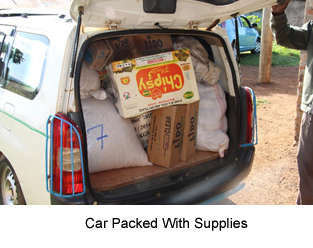
As usual, the weather in the morning to mid-afternoon
at this time of the year is beautiful. One of the first things
I noticed was how the road we were traveling on had been vastly improved since
the last time we had made this same trip. Apparently the new Kenyan government
has made a commitment to the people to improve the country by turning cow and
goat trails into roads that are now passable by cars. As always the road was
cluttered with motor bikes which transport the people from place to place.
Pastor Achilla pointed out to me one particular driver that had three people
hanging on for their lives as they sped by us.
While I have always found the countryside beautiful because of the recent rains, the abundant green foliage made our
trip spectacular. On several occasions, I asked our driver if he would stop so
that I could capture the scenery on camera.
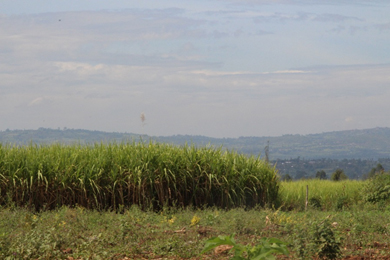
It was also apparent that my visit this time was in
the midst of planting season. The techniques for preparing the soil and putting
the maize seed into the ground varied from place to place. Because I still
follow farming as a significant part of my life, once more I asked our driver to
pull over so that I could take more photos.
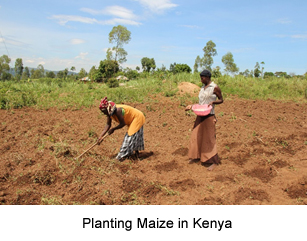
Finally after travelling for about 40 minutes, we
arrived at Widow Finter’s house. The last time I was there, it was under
construction. Now it has been finished although the home needs to have furniture
and mattresses for sleeping. At present, they sit and sleep on a cement floor.
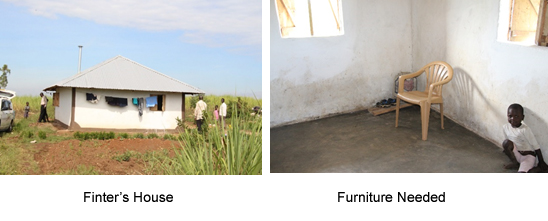
Finter was delighted to show me the area that had
been cultivated and some of the plants that were being grown. The red
tomato-like plants are actually a type of pepper plant. They had been harvested
from her garden and were being dried in the sun. When dried, the seeds would be
extracted and ground up for a spice that is apparently popular in Kenya. She
also has a patch of potatoes.
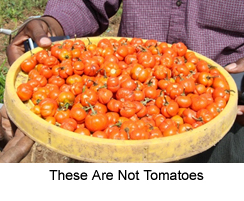
When I asked her about the new latrine that had
recently been built for her, she broke out with laughter and joy. She compared
what it was like in the past to the present when she and her family had to sneak
out into the sugarcane field nearby when nature called. Further, she could not
say enough about the “new style for Kenya” toilet that replaces “squatting over
a hole in the floor” with being able to sit down in comfort.
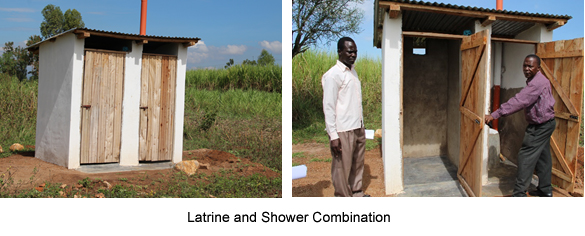
The other aspect of the latrines that we have
constructed is the fact there is also a second compartment for a shower. By a
shower, we are not suggesting that this involves hot and cold running water.
Water is brought to the shower in a pail, poured over the body in a cup by cup
procedure and then drained into the deep hole dug beneath the latrine.
These latrines that were funded by donors through
the Lighthouse Trails/Understand The Times Christmas donor project have been a
real blessing to our widowed families. In total, 16 were constructed in the
area. The neighbors surrounding the Bryce Homes marvel
at the construction, especially the new sit-down feature, and the word is being
spread how the Bryce Homes Program is impacting Kenya, not only physically and
spiritually, but also culturally.
Finally, after taking photos of the family and
individual shots, I walked around the house. As water is so difficult to come by
in this region, an idea came to mind. Why not harness rainwater of the newly
constructed metal roof and store it in a storage tank at one corner? Further,
because there is a great need for purified water to drink, and many are getting
ill because of bacterial and parasites, the time has come to find a system we
can incorporate for making the water safe to drink.

Before leaving, I asked Finter if she had any ideas
of what she would like to do if given the financial support to start her own
business and thus move in the direction of self-sufficiency. She told me she had
been thinking about this very thing for a long time and knew exactly what she
would like to do – set up a small shop or roadside Kiosk where she could sell
soap and household items. As you will see in later reports, all the widows we
asked this same question all had excellent ideas. All we will need is a small
amount of seed capital to get these widow-entrepreneurs off and running.
I was also delighted to find out that Finter is
teaching Bible classes in her area and many of her neighbors are hearing about
the gospel of Jesus Christ. This truly is what is at the heart of the Bryce
Homes program that has now been implemented around the world. Light is being
brought into the darkness and lives are being changed.
From Finter’s location, we continued on our way to
visit Widow Florence, also located in the same area. I will report about this
visit next.
Report 3 March 2014 Kenya
A meeting was arranged at Pastor
Achilla’s church Sunday evening in order to gather the widows and
orphans in the area in one location to greet me. I have been to
this same building several times before at other meetings. As we
approached the tin structure, I could hear the sound of voices singing
loudly.
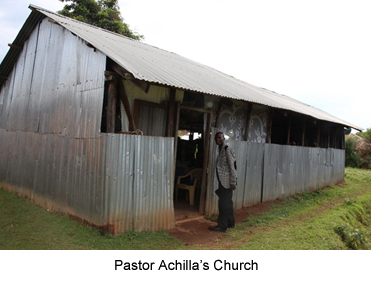
Over a
time period of about two hours nearly every adult at the meeting was
introduced and each person had a few words to say in welcoming me. I
shared a short message that I felt the Lord gave me from Isaiah 61: 1-3
explaining how the death of our son Bryce and the Bryce Home Program,
although a heartbreak and a tragedy for our family, was the inspiration
that initiated a plan that has now brought joy and happiness to many
unfortunate families round the world. I could see
many heads nodding in agreement as this portion of the Word of God was
very meaningful to them.
Some
of the Bryce Homes children had prepared several
songs especially for this meeting. Also, the widows of the families from
the Bryce Homes in the area stood up and introduced themselves.
Later six more widows who also attend the church but are not yet part of
the Bryce Homes Program were introduced.
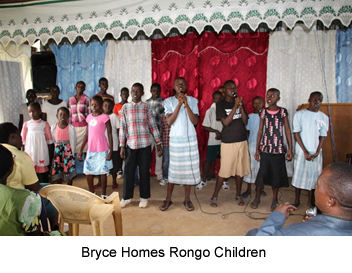
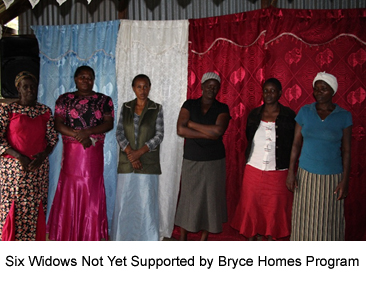
At the
end of the meeting as it was getting very dark, the rain started to pour
down on the tin roof. Pastor Achilla gave me a final opportunity to
address the group before concluding. I was thankful to be able to make
sure the meeting would end with the correct emphasis. It is
understandable that those who have received assistance from the
Understand The Times and Lighthouse Trails donor base see humans and
human organizations as their lifeline. Because this was obvious from the
comments, it was necessary for me to tell them not to focus on human
sources and resources and to make sure they were looking to and thanking
Jesus Christ alone. I told them we are only conduits the Lord uses as
vehicles to bring the blessings they have received
Also
without the diligent work of our ministry team, the Bryce
Homes Program would not be possible. Each month we rely on Pastor
Achilla, Pastor Nelson, and Walter to purchase the supplies and then
distribute them to each home. Also when new homes and latrines have been
constructed, this is done by their careful oversight. God has truly put
together a team.
I also
encouraged the widows of the Bryce Homes Program to be praying and
thinking of ways they can eventually become self-sufficient or at least
to work in that direction. While I am here, I will be discussing with
our leaders some possibilities. There are so many other widows and
families with the same basic needs who have not received support in the
past. Further, as children in the program become young adults, they will
have to pursue options that will allow them to move on and be an asset
to their church and community thereby being a blessing to others.
Today,
we will begin visiting the Bryce Homes and making
first-hand observations. I will be video-taping interviews that can be
later posted as short YouTube programs so that our donors can hear and
see for themselves how their resources are being invested.
.
Report 2 March 2014 Kenya
Our hotel in Nairobi was comfortable;
however, my body has not adjusted to the 11-hour time difference. I
slept for short periods of time waking up abruptly wondering if the sun
was about to rise. Finally, I got up and went downstairs to the lobby to
use the hotel business facility to print out some papers I had forgotten
to print before I left home.
During this process, I felt a tap on
my shoulder. When I looked around, I was startled to see Pastor Vitalis
standing behind me. Then I remembered that Pastor Achilla had told me he
was coming to the hotel before we left for the airport to see me.
Pastor Vitalis had brought four of his
children with him to meet me. Back at their home in the Kibera slums
were one more of his own and eleven orphans. We discussed the plan for
his entire family to move out of the slums in Nairobi to a home we have
built for them in western Kenya near our other Bryce Homes. He shared
with me his vision for developing the land that his new home is located
on and starting a small business for his family to sell fruit,
vegetables, and poultry.
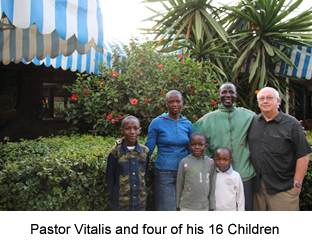
After Vitalis left, Achilla and I had
breakfast and then headed to the airport with our driver. On the way, I nodded off several times
then wakened as my neck was snapped back and forth as Steve navigated to
speed bumps designed to slow down the traffic as it passes through small
villages.
When we arrived at Homa Bay, located
right on Lake Victoria, we took a tour of the fish market. As Kenyans
love fish, I offered to buy a large pan full of Talapia as a gift for
our driver and also our Bryce Homes leaders.
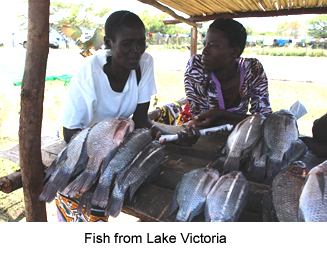
Later in the day, there will be a
gathering at Pastor Achilla’s church that I will be attending.
Report 1 March 2014 Kenya
I am writing this report as I am flying over
northern Africa on my way to Nairobi Kenya. The month of March is
the time for my annual visit to our Bryce Homes Program located in
western Kenya. Little did I know when I visited this area some four
years ago what would lie ahead. Initially beginning with five Homes,
the program has grown. Fifteen more Homes have been added so that we
now have twenty Homes and over 120 children.
The Kenya Bryce Homes Program has been a joint
partnership with Understand The Times and Lighthouse Trails. While
my initial trip was focused on the idea of working with Lighthouse
Trails to establish a discipleship training center in the area, my
attention was immediately drawn to the dire need of assisting widows
and orphans.
Lighthouse Trails shared this vision and together we
reported in our Internet newsletters what we felt the Lord was
leading us to do. Donors responded as we made some of the needs
public, and we were able to provide immediate emergency assistance
to several widows and their orphaned children who these Christian
women were trying to care for.
What makes our program viable in Kenya, as well
as in the three other countries where Bryce Homes have been
established, is the fact that we have solid trustworthy leaders who
direct the program on a hands-on basis. Monthly financial support is
transferred to them and they are responsible for purchasing food and
distributing it. Periodically we send funds for clothes and other
special needs. As these resources are distributed, documentation
(including photos) of their delivery is recorded and sent to us
verifying that our donors’ funds are being spent with diligence.
A major part of our program in Kenya has been
to advance the quality of life for these widows and orphans by
replacing shacks that can no longer be lived in. We have also been
able to provide the funds for school uniforms for each of the
children (a requirement for Kenyan schools). More recently, funds
were raised to construct outdoor latrines for each family. While I
am there, I will be interviewing the families we have been
supporting as well as our leaders to find how the program has made a
difference to their lives and what other needs exist.
Reports will be posted frequently on our web
site so that you will be able to track my progress on this trip.
Also when I return, I plan to post several small videos that will
document this trip.
